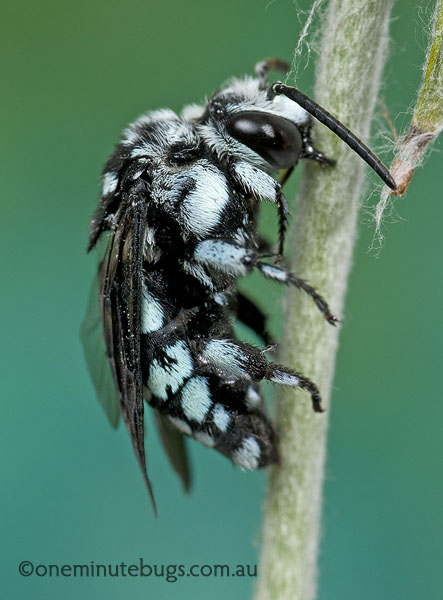Most of us are familiar with the activities of avian cuckoos where a bird lays its eggs in the nest of a host bird of a different species, after kicking out the eggs that were laid by the host. We have a dozen or so species of cuckoos in Australia and some of them utilise the nests of birds half their size. The worst mismatch I have seen was a pair of exhausted Superb Blue Wrens (Malurus cyaneus) trying to feed a massive fledgling Fan-tailed cuckoo (Cuculua pyrrhophanus). The young cuckoo was never happy with the amount of food brought to it and constantly pecked its foster parents.
Did you know there are insect cuckoos too? Granted there’s not a lot of the bullying going on like in the bird example described above, but there is certainly similar amounts of clandestine behaviour. There are about 75 species in the wasp family Chrysididae in Australia, with common species being referred to as “cuckoo wasps”. They vary in length from about 6 mm to 22 mm in length and they are strikingly beautiful insects because of their metallic colours.

Common cuckoo wasp species are noted for laying their eggs in the nests of mud-dauber wasps of the family Sphecidae and potter wasps of the family Vespidae. Some species of cuckoo wasps lay an egg into a mud nest cell while it is still open, and being provisioned by the host wasp. Other cuckoo wasp species chew their way into sealed mud nests to lay eggs.
When cuckoo wasp larvae hatch they may feed on the food stored for the host, or feed on the host larva, depending on the species of cuckoo wasp involved. Here is some terminology for you: if the cuckoo wasp larva feeds on and kills the host it is termed a parasitoid, but if it feeds on the host’s provisions it is known as a cleptoparasite. Either way the host larva dies.
Host wasps are armed with powerful jaws and stings, so cuckoo wasps try to enter nests when the host wasps are off gathering nest provisions. But they have evolved some defences if they are caught in the act. Cuckoo wasps have a very thick exoskeleton and they roll themselves into a ball and tuck their legs in to avoid damage.

I see blue-banded bees (Amegilla sp.) almost daily in the garden at my place in western Victoria. I enjoy their noisy buzzing and I know they are excellent pollinators. Unbeknownst to the blue-banded bees there is another species of bee, the cuckoo bee Thyreus sp. (below), which follows them and lays eggs in their nests. The cuckoo bee is a cleptoparasite. When its egg hatches inside the blue-banded bee nest the larva eats all the nectar/pollen provisions placed there by the blue-banded bee. When the blue-banded bee larva hatches from its egg, there is no food left and it dies.

There is one more group of usurpers worth mentioning and that is the parasitic wasps Gasteruption spp. (gasteruptids) of the family Gasteruptiidae. This slender wasp (below) lays eggs in the nests of several groups of native bees. This wasp is a parasitoid and a cleptoparasite – its hatching larvae feed on the eggs or larvae of the host bees and then the pollen store. It is particularly worrisome for people who keep bee homes/insect hotels – constructions that are now de rigueur in domestic horticulture. Gasteruption has an egg laying apparatus (ovipositor) longer than its body that can penetrate the tunnels and nests of native bees. This slender wasp is easily recognisable and may be seen hovering near flowers like a Will-o’-the-Wisp.

None of these parasitoids and cleptoparasites, be they cuckoo wasps sneaking up on mud wasp nests, or cuckoo bees tracking blue-banded bees, or wispy gasteruptids penetrating native bee nests, ever wipe out their hosts. It would be counter-productive for a parasitoid or a cleptoparasite to do so because that would mean their own death. As long as there is a balance all will be well – complicated certainly – but okay. The insect world, particularly the wasp world, is a very complex one.